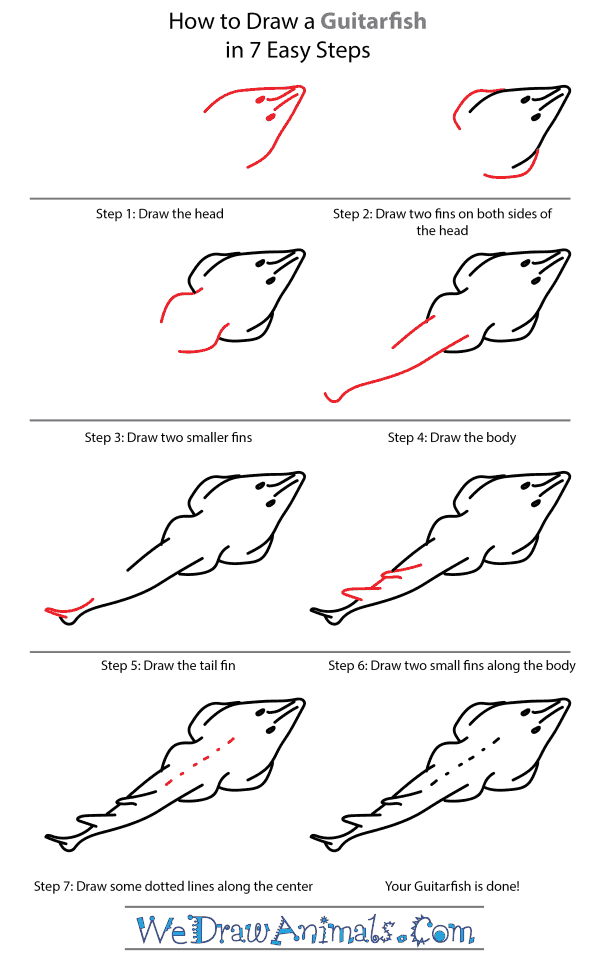In this quick tutorial you'll learn how to draw a Guitarfish in 7 easy steps - great for kids and novice artists.
The images above represent how your finished drawing is going to look and the steps involved.
Below are the individual steps - you can click on each one for a High Resolution printable PDF version.
At the bottom you can read some interesting facts about the Guitarfish.
Make sure you also check out any of the hundreds of drawing tutorials grouped by category.
How to Draw a Guitarfish - Step-by-Step Tutorial
Step 1: Draw a curved triangle looking shape, add two lines for definition and dots for eyes. This will form the head
Step 2: Draw a curved fin on either side of the head
Step 3: Draw two smaller fins inside of them to begin the body
Step 4: Draw two lines for the rest of the body
Step 5: Add a tiny, curved line for the tailfin
Step 6: Draw two smaller tailfins along the top part of the body
Step 7: Draw some dotted lines along the center to simulate more fins
Interesting Facts about the Guitarfish
The guitarfish is a bottom-dwelling species whose population has reached endangerment levels due to fishing efforts made by humans. They make their homes on the bottom of the Mediterranean Sea and the eastern Atlantic Ocean, though in many areas their population has dwindled greatly or disappeared entirely. Their bodies bear the shape of a stingray, with a flattened head and fins that strongly resemble stingrays and some species of shark. They can grow up to eighty inches, and have darkly colored tops of their bodies while their underbellies are white. This helps them to blend in to the ocean floor. They have very angular, pointed noses. Sometimes they will move up to shallower waters to rest, covering themselves in sand or dirt to remain cleverly hidden.
Did you know?
- The guitarfish breeds live young, up to twice a year. Each litter is four to ten in number, and pregnancy lasts around four months.
- Because this species of fish breeds in shallow waters, they are vulnerable to shrimp fishers. In some areas of their habitat, this fish is hard or impossible to ever see because of this.
- The largest populations of this fish reside in the Mediterranean Sea, where fishing isn’t as invasive or common.
- They like to swim in large schools of other guitarfish.
- Another reason why this fish is facing a population decrease is because their young are most often captured in fishing efforts. For the numbers to improve, these fish need to become old enough to successfully breed.
Arts and Crafts Activity Notes: This project will work best for a classroom or care center with a large class of children. Draw the guitarfish and then make and distribute copies for each participant in the activity. Instruct them to color in their fish with colored pencils, marker or crayon, and then carefully cut out the finished result. Proceed to decorate the bottom half of a wall or board in the room, to create your own school of low-swimming guitarfish!








